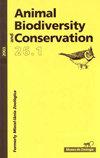Scientific and traditional knowledge meet: diet of the lowland tapir Tapirus terrestris in the Orinoquia region of Colombia
IF 1
4区 环境科学与生态学
Q3 BIODIVERSITY CONSERVATION
引用次数: 0
Abstract
The lowland tapir Tapirus terrestris is the second largest mammal in South America. It occupies a wide variety of ecosystems where it fulfills key functional roles. It is mainly folivorous, supplementing its diet with fruits, insects, and aquatic invertebrates. The lowland tapir is considered fundamental in shaping forest undergrowth and in seed dispersal processes. Despite its functional importance, ecological aspects related to diet, habitat use, and food preferences are still unknown in much of its geographic range. Currently, these aspects in the Colombian Orinoquia are unknown. We wanted to develop an approximation to the diet of the lowland tapir in the Colombian Orinoquia based on analysis of fecal samples and traditional knowledge derived from citizen science monitoring. Fecal samples were collected between October 2015 and July 2018 and vegetation monitoring and interviews with local communities were implemented. We recorded a total of 37 species of plants, 23 species of which were determined through traditional knowledge. The most representative species in fecal samples were Rudgea crassiloba, Attalea butyracea, Inga alba and Cecropia peltata. The plants most commonly recognized by local communities were Mauritia flexuosa, A. butyracea, Bellucia grossularioides and I. alba. Our results provide insight into the importance of tapirs in the consumption of large seeds such as M. flexuosa and A. butyracea that are considered of economic relevance for local communities. Incorporating citizen science monitoring allowed us to identify plant species that are taxonomically difficult to distinguish and to evaluate new information related to the natural history of cryptic species such as tapirs. This information is crucial to establish conservation strategies for the lowland tapir in the Orinoquia region of Colombia.科学和传统知识相遇:哥伦比亚奥里诺基亚地区低地貘的饮食
低地貘是南美洲第二大哺乳动物。它占据了各种各样的生态系统,在那里它履行着关键的功能角色。它主要以树叶为食,以水果、昆虫和水生无脊椎动物作为补充。低地貘被认为是形成森林灌木丛和种子传播过程的基础。尽管它的功能很重要,但在其地理范围内,与饮食、栖息地利用和食物偏好有关的生态方面仍然未知。目前,这些方面在哥伦比亚奥里诺奎亚是未知的。我们希望根据对粪便样本的分析和来自公民科学监测的传统知识,开发出哥伦比亚奥里诺奎亚低地貘饮食的近似方法。在2015年10月至2018年7月期间收集了粪便样本,并对当地社区进行了植被监测和访谈。我们共记录了37种植物,其中23种是通过传统知识确定的。粪样中最具代表性的种为大黄Rudgea crassiloba, Attalea butyracea, Inga alba和Cecropia peltata。当地群落最常认识的植物是毛蕊花、丁酸草、大花白顶花和白顶花。我们的研究结果深入了解了貘在消费大型种子(如M. flexuosa和A. butyracea)中的重要性,这些种子被认为与当地社区的经济相关。结合公民科学监测使我们能够识别在分类学上难以区分的植物物种,并评估与貘等神秘物种的自然史相关的新信息。这一信息对于制定保护哥伦比亚奥里诺基亚地区低地貘的策略至关重要。
本文章由计算机程序翻译,如有差异,请以英文原文为准。
求助全文
约1分钟内获得全文
求助全文
来源期刊

Animal Biodiversity and Conservation
农林科学-动物学
CiteScore
2.00
自引率
0.00%
发文量
21
审稿时长
>12 weeks
期刊介绍:
Animal Biodiversity and Conservation (antes Miscel·lània Zoològica) es una revista interdisciplinar, publicada desde 1958 por el Museu de Ciències Naturals de Barcelona. Incluye artículos de investigación empírica y teórica en todas las áreas de la zoología (sistemática, taxonomía, morfología, biogeografía, ecología, etología, fisiología y genética) procedentes de todas las regiones del mundo. La revista presta especial interés a los estudios que planteen un problema nuevo o introduzcan un tema nuevo, con hipòtesis y prediccions claras, y a los trabajos que de una manera u otra tengan relevancia en la biología de la conservación. No se publicaran artículos puramente descriptivos, o artículos faunísticos o corológicos en los que se describa la distribución en el espacio o en el tiempo de los organismes zoológicos.
 求助内容:
求助内容: 应助结果提醒方式:
应助结果提醒方式:


